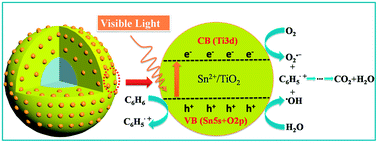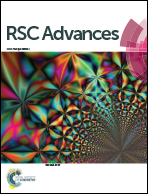Visible light-driven decomposition of gaseous benzene on robust Sn2+-doped anatase TiO2 nanoparticles†
Abstract
This work shows the efficient degradation of benzene over robust Sn2+-doped TiO2 nanoparticles prepared by a facile sol–gel route under visible light irradiation. The structure, optical properties and chemical states of Sn species incorporated into anatase TiO2 were carefully characterized by X-ray diffraction, transmission electron microscopy, Raman, UV-vis diffuse reflectance, X-ray photoelectron, X-ray absorption, and electron spin resonance (ESR) spectroscopy. The maximal conversion rate of benzene achieved is up to 27% over the Sn/TiO2 with a Ti/Sn atomic ratio of 40 : 1 and remains constant for a cyclic run of six days, indicating the high photo-stability for the decomposition of benzene. The characterization results reveal that the Sn2+-doping narrows the band gap energy of anatase TiO2, leading to a visible-light response. The photocatalytic degradation pathway of benzene was proposed based on the results of ESR and Fourier transform infrared spectra. These results offer a full comprehension of the visible light photocatalysis of Sn2+-doped TiO2 for degradation of volatile organic pollutants.


 Please wait while we load your content...
Please wait while we load your content...